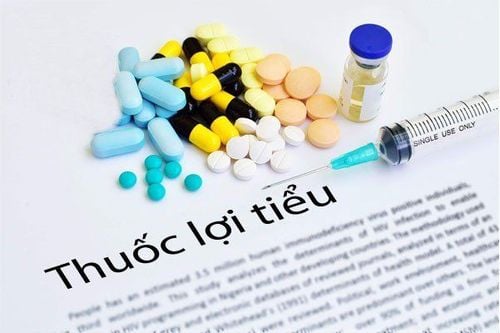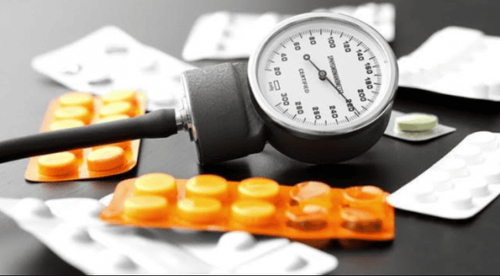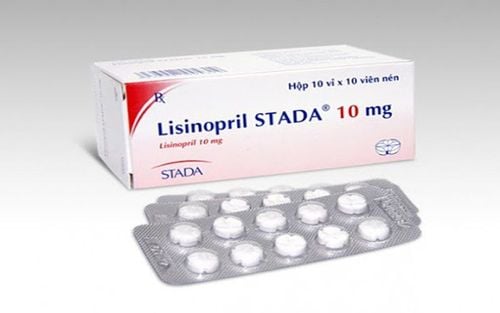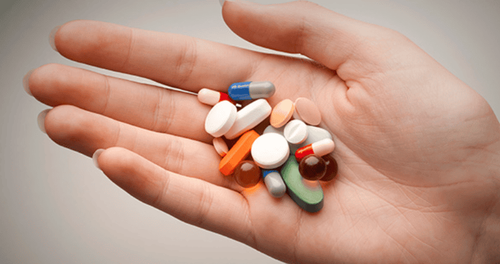This is an automatically translated article.
Ebitac 12.5 mg is a product of Farmak JSC, 74 Frunze str„ Kyiv, 04080, Ukraine, which is used in the treatment of high blood pressure or heart failure. On the market today, there is a lot of information about Ebitac 12.5mg drug product, but it is still incomplete. To better understand what Ebitac is a brand-name drug, what are the uses of Ebitac 12.5, let's learn more in the article below.
1. What is Ebitac 12.5 mg?
Ebitac 12.5 contains 2 active ingredients, enalapril, an angiotensin-converting enzyme inhibitor and hydrochlorothiazide, which is a thiazide diuretic used in hypertension and heart failure.1.1. Cardiovascular drugs subgroup.
1.2. Dosage Form Tablets.
1.3. Ingredients of the drug Ebitac 12.5 mg Each Ebitac 12.5 tablet contains:
Enalapril maleate 10mg. Hydrochlorothiazide 12.5mg. Excipients: Lactose monohydrate, potato starch, Povidone and Calcium stearate just enough for 1 tablet. 1.4. Pharmacodynamics of the drug Ebitac 12.5 mg Enalapril
Enalapril is an angiotensin converting enzyme inhibitor, it is active because enalaprilat is a metabolite of enalapril after oral administration. Enalapril reduces blood pressure in people with normal blood pressure, people with hypertension and has a good effect on hemodynamics in people with congestive heart failure and is mainly due to inhibition of the renin - angiotensin - aldosterone system. Enalapril prevents angiotensin from being converted to angiotensin II (a potent vasoconstrictor) by inhibiting angiotensin-converting enzyme (ACE). Enalapril also reduces serum aldosterone leading to decreased sodium retention, increases kallikrein-kinin vasodilatation and may alter prostanoid metabolism and inhibit the sympathetic nervous system.
Since angiotensin-converting enzyme plays an important role in kinin breakdown, enalapril also inhibits bradykinin breakdown. Since bradykinin is also a potent vasodilator, these two effects are attributed to enalapril which may explain why there is no proportional relationship between renin concentrations and clinical response to enalapril treatment.
In hypertensive subjects, enalapril reduces blood pressure by reducing total peripheral resistance with slight or no increase in heart rate, systolic output or cardiac output. The drug causes dilation of the arteries and possibly the veins. Enalapril will generally reduce systolic and diastolic blood pressure by about 10-15% in both the lying and sitting positions. Orthostatic hypotension and tachycardia are uncommon, but are more common in patients with hyponatremia or hypovolemia. In patients with congestive heart failure, enalapril, often in combination with cardiac glycosides and diuretics, reduces total peripheral resistance, pulmonary artery pressure, heart size and mean arterial pressure, and pressure. right atrium. There was increased cardiac index, cardiac output, systolic volume, and exercise tolerance. Enalapril reduces elevated afterload. Left ventricular hypertrophy subsides after 2 to 3 months of administration of an angiotensin-converting enzyme inhibitor, because angiotensin II is a potent stimulator of myocardial growth. Renal blood flow may be increased, however glomerular filtration rate is usually unchanged during enalapril treatment. Blood urea nitrogen (BUN) and serum creatinine are occasionally increased with long-term enalapril therapy, but are more common in patients with pre-existing renal injury or in those with renal vascular hypertension. In addition, renal function may be markedly worse during ACE inhibitor therapy in patients with pre-existing severe renal impairment.
In patients with diabetes , enalapril reduces urinary protein excretion . Enalapril has also been shown to increase insulin sensitivity in hypertensive patients with or without diabetes. Enalapril also did not reduce lipid metabolism to any extent.
Hydrochlorothiazide
Hydrochlorothiazide and thiazide diuretics will increase the excretion of sodium chloride and accompanying water by inhibiting the reabsorption of sodium and chloride ions in the distal tubule. The excretion of other electrolytes will also increase, especially potassium and magnesium, while calcium will decrease. Hydrochlorothiazide also reduces carbonic anhydrase activity, thereby increasing bicarbonate excretion, but this effect is usually small compared with the effect of Cl- excretion and will not significantly alter urine pH. Thiazides have a moderate diuretic effect, since about 90% of sodium ions have been reabsorbed before reaching the distal tubule, the primary site of action. Hydrochlorothiazide has a hypotensive effect, primarily due to a decrease in plasma volume and extracellular fluid associated with sodium diuresis. Later in the course of drug use, the antihypertensive effect depends on the decrease in peripheral resistance, through the gradual adaptation of blood vessels to the situation of decreasing Na + concentration. Therefore, the antihypertensive effect of hydrochlorothiazide appears slowly after 1 to 2 weeks, while a rapid diuretic effect can be seen as soon as a few hours. Hydrochlorothiazide will increase the effect of other antihypertensive drugs.
1.5. Pharmacokinetics of Ebitac 12.5 mg Enalapril
After oral administration, approximately 60% of a dose of enalapril is absorbed from the gastrointestinal tract. Peak serum concentrations are reached within 0.5 to 1.5 hours. The elimination half-life of the drug is about 11 hours. The hemodynamic effect lasts about 24 hours. Food will not affect drug absorption. After absorption, enalapril is extensively hydrolyzed in the liver to enalaprilat. Peak serum concentrations of enalaprilat occur within 3 to 4 hours. Oral administration of a single dose of enalapril usually results in a marked decrease in blood pressure about 1 hour after ingestion, maximum reduction in 4-6 hours, and usually persists for 12-24 hours. Blood pressure may decrease slowly and may take several weeks of treatment to achieve full effect.
The hemodynamic effects of enalapril will start more slowly and last longer than that of captopril. In patients with congestive heart failure, the hemodynamic effects of enalapril are apparent within 2-4 hours and may persist for 24 hours after a single dose. Approximately 50 - 60% of enalapril is bound to plasma proteins. Approximately 60% of the oral dose is excreted in the urine as enalaprilat and unchanged drug, the remainder of the drug is excreted in the feces.
Hydrochlorothiazide
After oral administration, hydrochlorothiazide is absorbed relatively quickly, about 65 - 75% of the dose used, but this rate can be reduced in people with heart failure. Hydrochlorothiazide accumulates in erythrocytes. The drug is eliminated mainly by the kidneys and is largely unchanged. The half-life of hydrochlorothiazide is approximately 9.5 - 13 hours, but can be prolonged in the presence of renal failure, requiring dose adjustment. Hydrochlorothiazide crosses the placental barrier, is distributed and reaches high concentrations in the fetus.
Diuretic effect will appear 2 hours after oral administration, reach maximum after 4 hours and last about 12 hours. The antihypertensive effect will occur much slower than the diuretic effect and can only be achieved after 2 weeks, even with optimal doses between 12.5 and 25 mg/day. It is important to know that the antihypertensive effect of hydrochlorothiazide will usually be optimal at a dose of 12.5 mg. Modern clinical trial and treatment guidelines emphasize the need to use the lowest and optimal dose that reduces the risk of adverse effects. It is important to allow sufficient time to assess your body's response to the hypotensive effects of hydrochlorothiazide, as effects on peripheral resistance also take time to become apparent.
2. What is the use of atizet?
Enalapril: after oral administration, it is converted to Enalaprilat, which belongs to the group of angiotensin converting enzyme inhibitors. Has the effect of lowering blood pressure and thanks to the following mechanism:
Prevents the formation of strong vasoconstrictor Angiotensin II by inhibiting ACE. Inhibits the Renin-Angiotensin-Aldosterone system and reduces serum aldosterone. From there, increase sodium excretion. Suppresses sympathetic nervous system. Alter the metabolism of Prostanoid and inhibit the breakdown of Bradykinin. Hydrochlorothiazide has a diuretic effect, thanks to the following mechanism of action:
Reduces retention of sodium chloride and water. Inhibits reabsorption of chloride and Na+ ions in the distal tubule and other electrolytes such as K+, Mg++, while calcium is reduced. Increased excretion of bicarbonate is due to decreased activity of the enzyme Carbonic anhydrase. Ebitac is used for the treatment of such conditions as:
Hypertension. Congestive heart failure. Heart attack . Renal hypertension, diabetic nephropathy and renal failure. Left ventricular dysfunction is asymptomatic. Patients need to learn more about other effects of the drug and need to contact a doctor or specialist pharmacist directly for more information.
3. Side effects of the drug Ebitac 12.5 mg
During the use of Ebitac 12.5, patients may experience some side effects with different frequencies listed below:
Common:
+ Headache, dizziness, insomnia, fatigue, and confusion or paralysis cold
+ Diarrhea, nausea, vomiting, taste disturbance and abdominal pain.
+ Angioedema, hypotension, chest pain, palpitations and syncope.
+ Rash.
+ Kinin, Prostaglandin in the lungs increased and dry cough.
+ Kidney failure.
Uncommon:
+ Decreased granulocytopenia, neutrophils, Hematocrit and Hemoglobin.
+ Agitation, severe depression and panic attacks.
+ Proteinuria.
Rare:
+ Toxic cholestatic hepatitis, pancreatitis, intestinal mucosal hyperesthesia and intestinal obstruction.
+ Hypersensitivity, blurred vision, stuffy nose, asthma, bronchospasm and myalgia.
If you see the above side effects, immediately notify a qualified doctor or pharmacist for timely treatment.
4. Drug interactions
Use caution in combination with the following drugs:
In relation to Enalapril:
+ Other vasodilators, such as nitrates, anesthetics: may cause a severe drop in blood pressure.
+ Diuretics: sometimes will lower blood pressure excessively.
+ Renin-releasing drugs: increase the effect of Enalapril.
+ Substances that increase blood potassium, such as potassium-sparing diuretics, potassium supplements, potassium-containing salts: increase serum potassium levels.
+ Increasing the concentration of Lithium will lead to increased toxicity.
+ Non-steroidal anti-inflammatory drugs, sympathomimetic bronchodilators: reduce the antihypertensive effect of Enalapril.
+ Oral contraceptives: lead to difficulty controlling blood pressure and increase the risk of vascular damage.
Related to Hydrochlorothiazide:
+ Barbiturates, narcotic sleeping pills, alcohol: increase the possibility of orthostatic hypotension.
+ Other antihypertensive drugs: synergistic and cause hypotension.
+ Increased response to muscle relaxants, hypertensive amines and Lithium.
+ Non-steroidal anti-inflammatory drugs reduce the effectiveness of Hydrochlorothiazide.
+ Quinidine: increases the possibility of torsades de pointes, even death due to ventricular fibrillation.
+ Reduce the effect of anticoagulants, gout treatment, Colestipol and cholestyramine resin.
+ Increases the effect of anesthetics, Vitamin D and Glycoside.
To ensure safety and effectiveness, tell your doctor about all medicines, health foods you are taking and other diseases you have.
5. How to use Ebitac brand-name drug effectively
Dosage of Ebitac 12.5 is also determined primarily by the dose and administration of the ingredient enalapril maleate. The dosage of the drug must also be individualized.
5.1. Adults Hypertension:
The usual dose is one pill, once daily. If necessary, the dosage can be increased to two tablets, once daily.
Concomitant diuretic therapy:
Symptomatic hypotension may occur after the initial dose of Ebitac 12.5. Therefore, diuretic therapy should be discontinued for 2 - 3 days before initiating therapy for this patient. with Ebitac 12.5.
Dosage in Renal Impairment:
Thiazides are generally not suitable for patients with renal impairment and are ineffective at creatinine clearance values of 30 ml/min or lower (i.e. moderate or severe renal impairment). In patients with creatinine clearance > 30 and < 80 ml/min, Ebitac 12.5 should be used only after titration of the drug components. Special dose adjustment is required during combination therapy with other antihypertensive agents. Within 4 weeks, if no results are achieved, the dose must be increased or another antihypertensive agent should be considered.
Heart failure:
Ebitac should be used under the supervision of a doctor. If the patient has severe heart failure (grade 4), impaired renal function and/or electrolyte abnormalities, they must be carefully monitored in the hospital from the moment you start treatment. This principle has also been applied when combining Enalapril with vasodilators. The appropriate dose for the first week is 2.5 mg Enalapril once daily for the first 3 days, 2.5 mg Enalapril twice daily for the next 4 days.
Note: Patients should take Enalapril 5 mg tablets to get the right dose for the first time of treatment, or consult the treating doctor. The dose can then be gradually increased to the normal maintenance dose of 20 mg (2 Ebitac 12.5) daily, administered once or in 2 divided doses in the morning and evening. In rare cases it may be necessary to increase the dose to 4 Ebitac 12.5 tablets/day. Adjust dose over 2 to 4 weeks.
Asymptomatic left ventricular dysfunction:
Initial dose is 2.5 mg Enalapril administered twice daily in the morning and evening; Adjust the dose continuously until the appropriate dose as described above up to a dose of 2 tablets Ebitac 12.5/day, divided into 2 times, used in the morning and evening.
Note: Patients should take 2 tablets of Enalapril 5 mg to get the right dose for the first time of treatment, or consult the treating doctor. Blood pressure and renal function should be closely monitored before and after initiation of therapy to avoid severe hypotension and renal failure. If possible, the diuretic dose should be reduced prior to initiating treatment with Enalapril. Serum potassium levels should be monitored and adjusted to normal.
5.2. Elderly In clinical studies the efficacy and tolerability of enalapril maleate and hydrochlorothiazide used concomitantly was similar to that in hypertensive patients in both the elderly and the young.
5.3. Children Efficacy and safety for use in children have not been established. Please consult your doctor immediately before use.
Note: The above dosage is for reference only. The specific dose will depend on the condition and the progression of the disease. To get the right dose, you need to consult your doctor or medical professional.
5.4. What to do in case of overdose? There is limited data on overdosage of enalapril in humans. The hallmark of enalapril overdose is severe hypotension. In the event of an overdose, enalapril therapy should be discontinued and the patient closely monitored, and symptomatic and supportive measures instituted, such as induction of vomiting, gastric lavage, and intravenous infusion of plasma and sodium. chloride to maintain blood pressure and treat electrolyte imbalances. Hemodialysis may remove enalapril from the circulation.
Manifestations of overdosage of hydrochlorothiazide will mainly be fluid and electrolyte disturbances due to excessive diuresis. If you are taking digitalis, hypokalemia increases arrhythmias.
5.5. What to do if you miss a dose? If you forget to take a dose, take it when you remember it. However, when it is almost time for your next dose, skip the missed dose and take your next dose at the scheduled time. Do not use double the prescribed dose.
6. Note when using medicine and how to store it
6.1. Use in pregnant women and lactating mothers Pregnancy:
Use in the second and third trimesters of pregnancy can lead to injuries, even death in infants such as :
+ Lower blood pressure.
+ Renal failure is reversible or irreversible.
+ Decreased cranial hypoplasia.
+ Thrombocytopenia.
+ Simple electrical disorder.
+ Jaundice.
Therefore, to ensure absolute safety, do not use during pregnancy.
Lactation : The drug is excreted in breast milk and will inhibit lactation. Therefore, a decision must be made between stopping breastfeeding or discontinuing the drug.
6.2. For those who drive and operate machinery, Ebitac 12.5 may cause headaches, dizziness, fatigue, ... affecting the ability to drive. Care must be taken during use.
6.3. Storage conditions Temperature below 30 degrees C. Protect from light.
Please dial HOTLINE for more information or register for an appointment HERE. Download MyVinmec app to make appointments faster and to manage your bookings easily.













